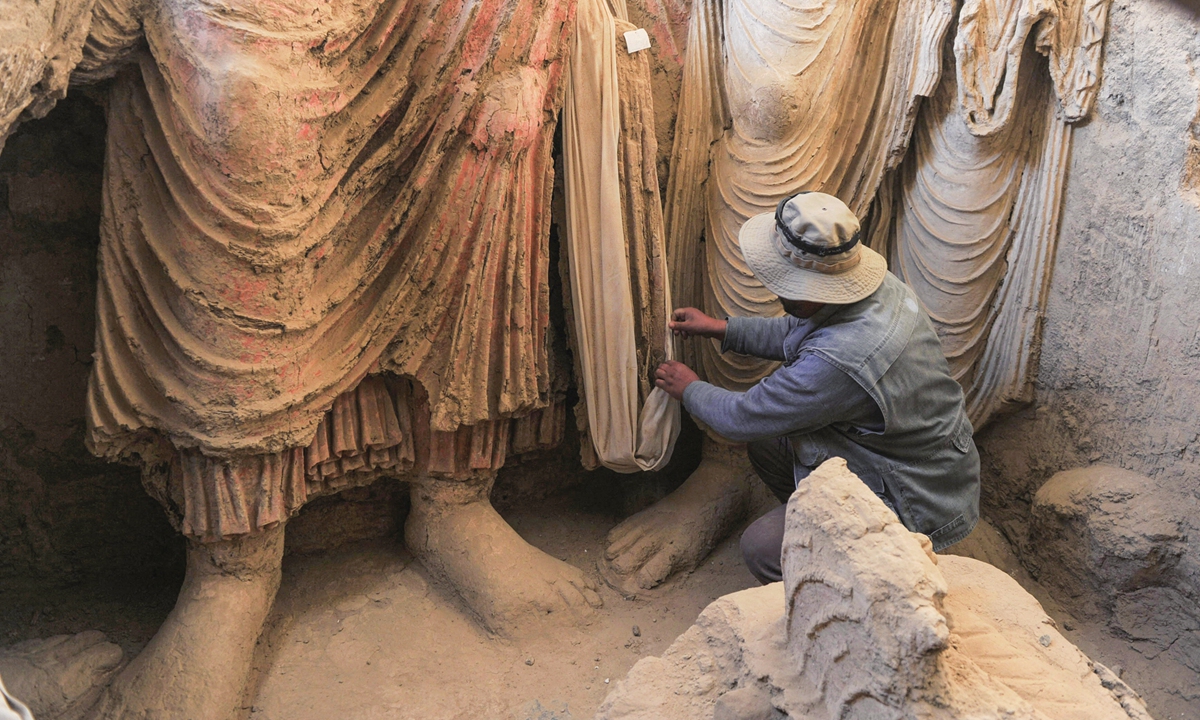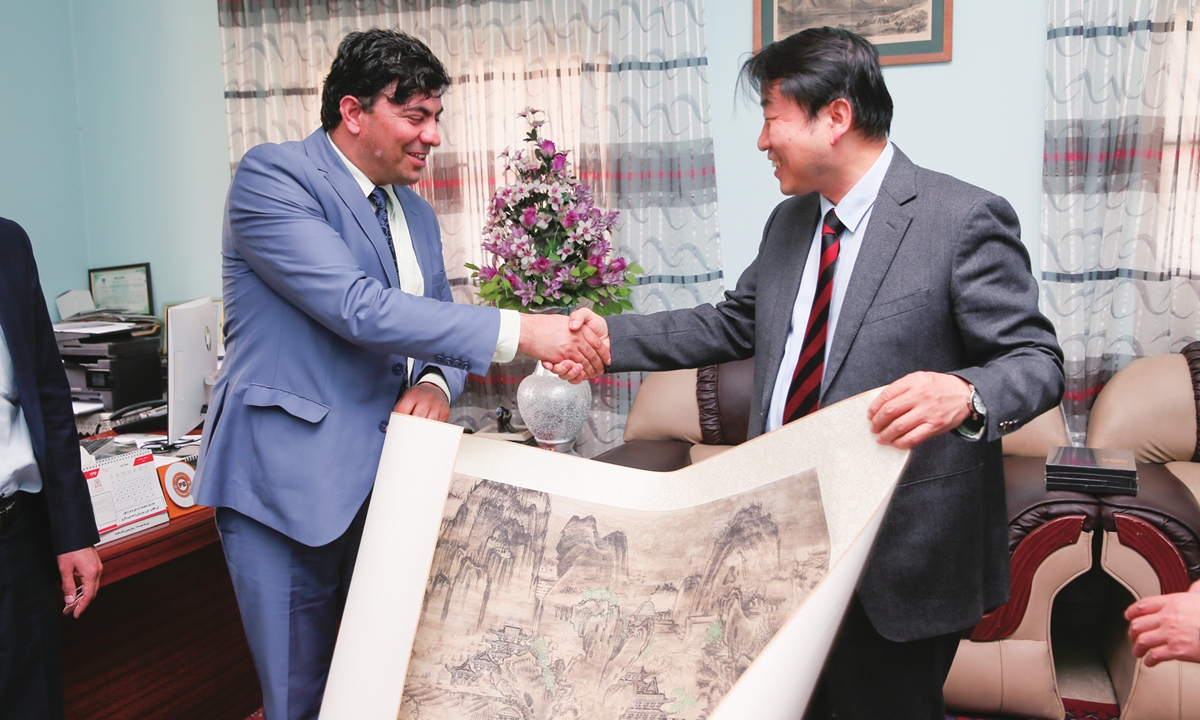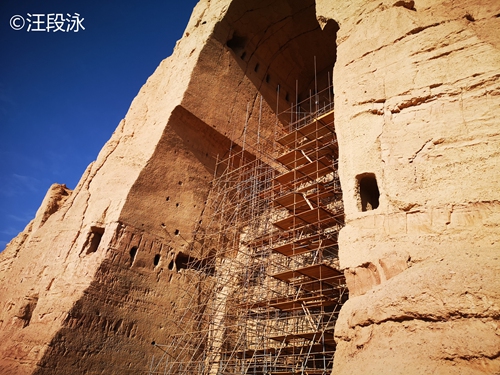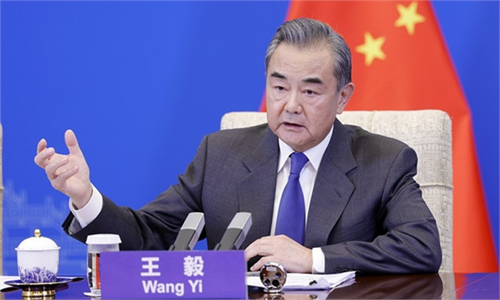Chinese scholars willing to lend a helping hand to Afghan counterparts in conserving relics along the Silk Road

An Afghan archaeologist looks at the remains of Buddha statues discovered inside an ancient monastery in Mes Aynak, in the eastern province of Logar of Afghanistan on November 23, 2010. Photo: AFP
As Afghan Taliban tries to find ways to best conserve Buddha statues, China's state-of-the-art conservation of Buddhist artworks at the Mogao Caves can provide help for the war-ravaged country toward cultural heritage conservation, considering China and Afghanistan's similar historical grotto construction practices and close ties in ancient times along the Silk Road, experts said.
Chinese cultural relics experts are now opening exchange channels for cultural relic conservation, management, and research with their Afghan counterparts via established cooperative projects, and they look forward to sharing restoration techniques such as environmental monitoring devices and digital imaging equipment, via in-person visits once the time is right, the Global Times learned.
Afghanistan is the quintessential "crossroads of cultures" where the civilizations of the Central Asia, South Asia, and China interacted for thousands of years in a dynamic mixture of trade, cultural exchanges, and migration. The country is home to two UNESCO World Cultural Heritage Sites: The Cultural Landscape and Archaeological Remains of the Bamiyan Valley and the Minaret of Jam.
Though replete with rich cultural heritage, many countries along the Silk Road such as Afghanistan barely have frameworks in place to safeguard the preservation of said artifacts due to an expertise deficit and outdated technology and are in dire need of professional assistance, observes said, stressing such cooperative protections are valuable to both China and Afghanistan as the relics depict historical and cultural interactions among the region's civilizations.
"With similar geographical conditions, the mature sets of conservation techniques and digital recording tools for earthen sites and murals in the Mogao Grottoes - a world cultural heritage site in Dunhuang - can be valuable for these countries," Zhang Xiaogang, the director of Archaeology Institute of Dunhuang Academy in Northwest China's Gansu Province, told the Global Times.
Political observers said that the Taliban's shift in attitude toward cultural preservation may suggest that the Taliban is moving closer to becoming a "multicultural and inclusive government" that the international community has come to expect.
Long-awaited reboot
The Taliban recently vowed to guard the ancient Buddha statues discovered early in 2010 by a contracted Chinese construction team at the Mes Aynak mine in rural Afghanistan.
The Taliban's milder stance on the preservation of Buddhist culture has sparked hopes for restoring ruined Buddha statues in Afghanistan's Bamiyan Grottoes.
"The Bamiyan Grottoes are very similar to the Mogao Grottoes in Northwest China's Gansu Province as well as the Kumtura Thousand Buddha Caves in Xinjiang Uyghur Autonomous Region. More than 750 Buddhist caves were hollowed out along the Bamiyan Cliff including the two most famous niches with giant Buddha statues (55m and 38m high) destroyed by the Taliban in 2001. These figurative murals had a profound influence not only on Chinese Buddhist art but also across the whole of East Asia in countries such as Japan and Korea," Chinese archaeologist Shao Xuecheng said in an online public speech in February. Shao has been to Bamiyan several times to study the local cultural relics.
The study of Buddhist culture and art in Afghanistan and other surrounding areas helps us further understand the routes of Buddhism's spread, Zhang told the Global Times.
Zhang noted that the restoration of the Bamiyan Buddhas is currently facing many challenges. However, he believes that there is still a great deal of investigation and conservation work to be done on the caves surrounding the Bamiyan Buddhas.
"With a strong yearning to understand the relics' glorious history and the culture of the region, and to better develop tourism, many local experts and scholars would like China to provide them with relevant research materials from the international academic community to help them understand when, by whom, and why the Bamiyan caves were built. What is the relationship between the Bamiyan caves and the Dunhuang Grottoes? They also hope Chinese scholars will collaborate with them to groom domestic research talent," Zhang told the Global Times.

Chinese and Afghan scholars exchange gifts as a Chinese expert delegation visited the National Museum of Afghanistan on March 25, 2018. Photo: Courtesy of Sun Zhijun/Dunhuang Academy
China can offer more valuable experience in helping Afghanistan rebuild its own "cultural relic protection system," which was destroyed amid decades of war, Wang Duanyong, an associate professor in international relations at the Shanghai International Studies University, told the Global Times.
After the withdrawal of much foreign aid following the Taliban's return to power in August 2021, conservation and research efforts in Afghanistan were largely halted due to funding and talent constraints. The urgency around rebuilding the cultural relic protection system and the training of talents in the field is great, said Wang.
"Taking the National Museum of Afghanistan that is considered to be one of the world's greatest repositories of ancient cultures, where I recently visited, as an example, a large number of relics wait to be restored by just two experts. The extreme lack of personnel, investment, and experience are the main difficulties they face," said Wang, who visited Afghanistan in December 2021 and February this year respectively.
Mohammad Fahim Rahimi, the director of the National Museum of Afghanistan, was highly impressed by China's advanced cultural relic protection system during his visits to China and hopes that China can offer more support and personnel exchanges opportunities in the future, Wang said.
Open channels
The inaugural cultural relic research trip led by a group of Chinese archaeologists from the Dunhuang Academy to Bamiyan was done at the end of March 2018.
The delegation visited three caves in the Bamiyan Valley, Kakrak, and Foladi, and six ancient cities, pagodas, and monasteries in Kelligan, Tang-I Safedak, Chilborj, Zohak, and Gholghola, recalled Zhang, who was in the team.
"It was a friendly, introductory, and dream-fulfilling trip. During the expedition, we discovered that many of the sites were deep in inaccessible mountains. We often climbed high mountains and cliffs on our hands and knees. But whenever we saw a pagoda, a Buddhist temple site, a unique grotto, or a surviving mural, we were so excited that we forgot about how tired we were," Zhang said.
Through the trip, the Chinese experts gained a deeper understanding of the status and preservation of the numerous archaeological sites in Bamiyan, the routes of how Buddhist culture spread in the region, and art along the Silk Road, and the similarities and differences between the Bamiyan Caves and the Dunhuang Grottoes, as well as their historical origins.
Zhang noted that during their visit, the China Dunhuang Grottoes Conservation Research Foundation announced a $15,000 grant to the National Museum of Afghanistan and the Bamiyan to support mutual academic exchanges in the study of Silk Road history and cultural heritage conservation.
As part of the Chinese commitment to help bolster local cultural relic conservation, the Academy also invited two professors from the Bamyan University for a research trip to Dunhuang to learn about the local heritage protection work.
The scholarly and expertise exchange program under the agreements is expected to resume in the near future, Zhang noted.
Positive signs
Urgent calls to protect Afghan cultural workers and safeguard the country's cultural heritage were strong after the Taliban came to power in August 2021.
Amid global concerns, the Taliban has vowed to protect local cultural heritage repositories as they posted a small group of armed guards outside the national museum, for example, to prevent looting in August 2021, according to the director, Mohammad Fahim Rahimi, the New York Times reported.
The Taliban's positive response was seen as a sign that they are trying to move toward a more inclusive government, observers said.
"As far as I know, in 2019, the Taliban actually reached out to a number of foreign archaeologists and promised to support international cooperation in cultural heritage research. And fortunately, few reports of military attacks or the destruction of cultural heritage sites have been reported since the Taliban took power in August 2021," Shao suggested.

Scaffolding is erected at the cave of the destroyed Bamiyan Buddha statue. Photo: Courtesy of Wang Duanyong
The Taliban's positive statement shows that it does not want to turn Afghanistan into a closed country, but a more open one to gain global recognition and further global exchanges and investment, Cao Wei, an expert on security studies at Lanzhou University, told the Global Times.To build a more open and inclusive direction is probably a deliberate move by the Taliban, just as they have hired many ethnically diverse officials, Wang said.
Though there are recognizable efforts to move the country toward a more multicultural and inclusive government, the international community is waiting for more signs that the country embraces cultural pluralism, Cao said.
Sidebar: Historical and Cultural Exchanges between China and Afghanistan
September 2017: An expert team from the National Museum of Afghanistan visited the Mogao Grottoes and had an informative discussion.
November 2017: The Dunhuang Academy hosted a "From Bamiyan to Dunhuang" Silk Road Culture and Art Research Class.
From August to October 2017: The Dunhuang Academy hosted an "Legendary Treasures of the Silk Road - Precious Collection from the National Museum of Afghanistan" exhibition.
March 2018: China sent a delegation of archaeological experts to Afghanistan for the first time
March 2019: Scholars from Bamyan University paid an academic visit to the Mogao Grottoes.
November 2021: Wang Xudong, director of the Palace Museum, invited 21 well-known Chinese and overseas scholars to jointly launch an open initiative calling for greater efforts to protect Afghanistan's cultural heritage.
December 2021 The National Museum of Afghanistan reopened. The director thanks Chinese colaborative friends in an interview.
From March 2017 to May 2019: 231 treasures from the National Museum of Afghanistan were exhibited in nine museums and cultural institutions in eight locations in China



